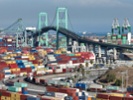 
|
Top Stories
The 2025 Top Workplaces list has recognized 58 distributors and logistics firms across three size categories based on employee feedback on metrics including workplace culture and employee engagement. Several members of the National Association of Wholesaler-Distributors were included in the lists, including Graybar, Kirby Risk, Conklin Metal Industries, Skidmore and Schaedler Yesco Distribution.
Small businesses could face $200 billion a year in tariff costs with current import rates, according to the US Chamber of Commerce, whose calculation is based on Census Bureau data showing that 236,000 small businesses imported $868 billion in goods last year. Increased expenses, driven by sweeping new tariffs, are expected to make everyday goods and production more expensive for small businesses, with unpredictable supply chains adding further challenges. The Chamber is urging the White House to consider a tariff exemption process for small enterprises.
|
|
 |
| The Port of Los Angeles (Allen J. Schaben/Getty Images) |
The Port of Los Angeles handled a record 1,019,837 20-foot equivalent units in July -- the highest monthly volume in the port's 117-year history -- as importers rushed to bring in goods before new import tariffs took effect. The surge resulted in jam-packed terminals, but has since started to subside, with fewer container ships scheduled to arrive in the coming weeks.
Amazon has launched a significant grocery expansion, offering same-day delivery of fresh groceries to Prime members in more than 1,000 cities and towns. The service, which includes perishable items like produce, dairy and meat, aims to reach over 2,300 locations by year-end. Amazon has piloted the service in cities such as Phoenix and Orlando, seeing strong customer adoption, with 75% of users being first-time shoppers for perishables.
|
Operations and Technology
Retailers and consumer brands face renewed volatility in 2025, driven by rising import costs, inflation and unpredictable demand, with tariffs at the center of the uncertainty, leading many organizations to delay or pause orders, which in turn affects factory output and inventory, writes Rodney Manzo, senior director of global operations at Sage. Some companies are investing in supply chain technology, automation and real-time analytics to enhance visibility, diversify suppliers and future-proof their operations.
|
|
 |
| (Sakorn Sukkasemsakorn/Getty Images) |
Companies are increasingly turning to a multi-dimensional decision framework to guide supply chain strategy amid tariff volatility, writes Prashant Dubey, the CSO of Agiloft. Instead of relying solely on cost considerations, this approach requires balancing customer price sensitivity, market share implications and long-term supplier relationships. Procurement leaders must weigh options like cost absorption, selective price adjustments and supplier network restructuring -- supported by rigorous financial modeling and scenario-based analysis, Dubey notes.
|
Sales and Marketing
B2B buyers now expect vendors to deliver accessible services, and accessibility is becoming a standard requirement in requests for proposals and contracts, writes Jonathan Hassell, CEO of Hassell Inclusion. Hassell highlights how embedding accessibility from the outset--by involving people with disabilities in design and testing--ensures that digital products meet the needs of all users and aligns with evolving expectations in the B2B landscape.
LinkedIn has released insights highlighting what works best for B2B campaigns, emphasizing the growing traction of video content. The platform notes that video is essential for maximizing reach and engagement, urging marketers to rethink strategies and explore new platforms.
|
The Business Leader
|
|
 |
| (Thinkhubstudio/Getty Images) |
As AI becomes more prevalent in the workplace, directors and managers are noticing a decrease in entry-level hiring, which in turn threatens the talent pipeline, writes Cornelia Walther, a visiting scholar at the Wharton School of the University of Pennsylvania. Because AI can replace entry-level tasks, junior employees are losing opportunities to develop skills through repetition and mentorship. This is coinciding with one of the largest retirement waves in modern history, which can create a knowledge gap that could hurt long-term organizational growth.
US companies have halved cash allocations since 2021, dropping to 20% from 40%, as high interest rates drive a shift toward higher-yielding Treasury bills, according to Clearwater Analytics. Median allocations to Treasury securities have surged from 3% to 20% during the period. "Corporations are still adding duration because they know the duration risk is minimal, because the likelihood that the Fed hikes is much lower than the likelihood that the Fed cuts," Clearwater's Matthew Vegari says.
|
NAW Insider
Prioritize your organization's greatest asset — your people. NAW's premier education programs, such as the online Management Academy and the in-depth Distribution Leadership Program at THE Ohio State University, are designed to equip your high-potential employees with the skills and insights they need to lead and succeed. Ensure your rising stars are prepared to drive your business forward by investing in their growth today. Learn more about how NAW can help you develop the leaders of tomorrow.
|
Editor's Note
You may have noticed your newsletter looks different today. The SmartBrief team has been hard at work designing a more intuitive, accessible experience for professionals like you. Read more about the project, and use the feedback link at the bottom of the newsletter to let us know what you think!
|
| Help Spread the Word |
|
|
| Or copy and share your personalized link: |
| newsletter.smartbrief.com/naw/?referrerId=lfbdlNyHyu |
|
| Got this from a friend? Subscribe now and stay in the loop! |
|
 |
|
| |
| Hang on to your hat. Hang on to your hope. And wind the clock, for tomorrow is another day. |
E. B. White,
writer |
|
| |
 |
|
|
